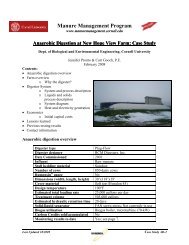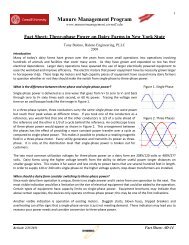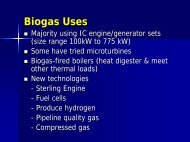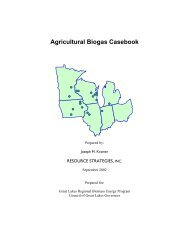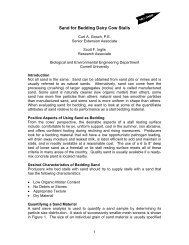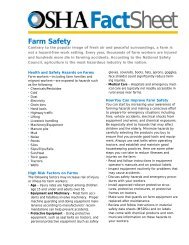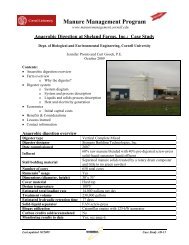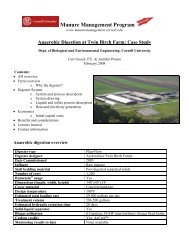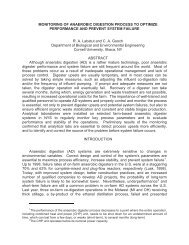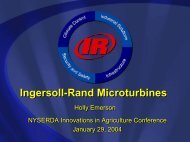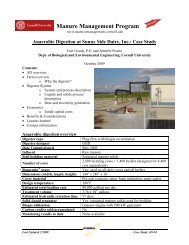System and Process DescriptionThe digester system at Spring Valley Dairy is composed of several subsystems (See Figure 1):• <strong>Manure</strong> collection• Activation system• Covered manure storage• Engine generator set• FlareSeed SludgeFigure 1. Schematic of the manure activation and covered storage on Spring Valley Dairy (by Stephen Hoyt)Unlike other anaerobic digester systems, which have a single “tank” that holds and processesmanure for biogas production, this system has two “tanks”. One is the activation system thatuses special small-scale reactors designed to provide sufficient seed sludge to effectively activatethe storage pit for biogas production. The continuous seed process helps maintain high levels ofmethanogenic organisms in order to facilitate the bacterial population growth in the storagedespite varying quantities of manure substrate. Another much bigger tank, the covered manurestorage pit, holds and processes manure for biogas production with a much longer retention time(2–12 mo.)With 236 animals on the farm, the manure production is about 3,400 gallons per day. Themanure utilizes gravity to flow from the barn collection system to the manure pit, from which itis pumped into the activation system. These consist of two seed digesters with a capacity of1,000 gallons each. The converted manure storage pit has a capacity of 300,000 gallons. Aflexible, impermeable cover added to the top of the pit traps the biogas. The retention time is 20days for the activation digesters and 90 days for the manure storage pit.Heat and Electricity GenerationBiogas production is projected to be about 6,000 cubic feet per day, which has a methane (CH 4 )content of 60%, 40% CO 2 , 0.3% H 2 S and other trace gases. The biogas will be collected and fedLast Updated 12-7-20042<strong>Case</strong> <strong>Study</strong> <strong>AD</strong>-6
into an Isuzu diesel engine attached to a 25 kW generator. Because of the corrosive hydrogensulfide in the biogas, engine oil will be changed regularly.This engine-generator set has a projected electricity production of roughly 219,000 kWh/year,which can potentially supply all the electrical needs of the farm, or another flexible use systemsuch as an absorption chiller for cooling milk. Moreover, the recovered heat from the generatorwill be used to help facilitate anaerobic digestion activity in the existing manure storage, and atsame time provides hot water for other uses on the farm.Economic InformationCapital CostsDigester- Digester Construction and Materials- PumpsSubtotalEngine-Generator Set- Engine Generator- Switching Equipment- Engine BuildingItems Cost/Benefit *$38,000$2,300$40,300$20,000$5,000$2,000$27,000Subtotal<strong>Manure</strong> Storage (Existing) $35,000Cover for <strong>Manure</strong> Storage Pit $18,000Sand Removal System $8,000Others $15,350Total Capital Cost $143,650Total Annual Capital Cost ** $14,961Annual Operating Costs Maintenance, Repairs, Labor, Fuel, Insurance, etc. ***$8,022Savings on Electricity and Heat -$13,500Annual BenefitsSavings on Reduced Rainwater -$3,750Total Annual Benefits -$17,250Annual Net Cost Per Cow ($/cow/year) $22.93Note: * The operating costs (maintenance and repairs) and revenues are projected numbers as of August 19,2003. An updated analysis will be provided with real data once the system is operated for one year.** Total Annual Capital Costs = Annual interest charge of 5% plus depreciation.*** Spreading Costs are not included on this system. They are not materially different with the treatment system.Based on the cost-benefit analysis, the annual net cost is about $22.93/cow/year for odor controland waste stabilization. The capital cost for this system is $143,650. This is low for a farm thatcan’t take advantage of the economies of scale that typical 500-1,000 cow farms withconventional digesters have. This system also includes the storage, while the typical capitalcosts for plug-flow digesters, which range from $500 to $800/cow, do not include the storage.Environment BenefitsSince the installation of the anaerobic digester system on Spring Valley Dairy, the odor frommanure handling and spreading has been greatly reduced. The nutrients in manure are alsocontrolled and the pathogens are likely also reduced.Advantages and DisadvantagesAdvantages- Odor Control- Energy ProductionDisadvantages- Adding Complexity to Farming- Dedication to Digester System <strong>Management</strong> (i.e.Last Updated 12-7-20043<strong>Case</strong> <strong>Study</strong> <strong>AD</strong>-6



